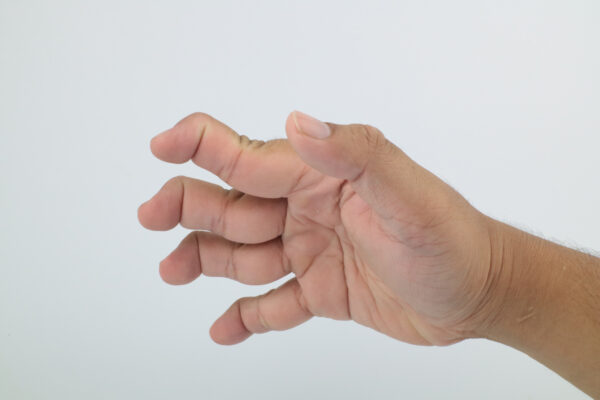

Blue x’s to signify middle and top joint and arrows are the direction of flexion (top, or closest to nail joint) and hyperextension (middle joint).
What is Swan Neck Deformity?
Swan neck deformity is defined as a physical finger deformity which is associated with a finger that bends back at the middle joint and bends forward at the top joint in a manner that is not typical. This structural change to the finger alignment is due to ligament laxity or injury of the side ligaments to each finger joint. This positioning of the finger is sustained and can make it difficult to perform functional tasks with the hand.
Swan Neck Deformity Symptoms
Symptoms of Swan Neck Deformity include:
- Physical abnormalities of the top and middle finger joints
- Difficulty bending the middle joint
- Potential pain with grasping motions
- Snapping sensation while bending the finger joints
- Finger stiffness
Swan Neck Deformity Causes
This finger deformity can be caused by weakness or injury to the ligament on the palm side or two side ligaments of the middle joint of fingers. Injuries that impact the ligament’s structure such as tearing of the ligaments protecting the finger can affect the physical structure of the middle and top joint alignment. Rheumatoid Arthritis can affect the structure of the fingers thus creating a swan neck deformity, as well.
Conservative Treatment for Swan Neck Deformity
Splinting using an oval-8 orthosis is important to allow the structures of the fingers involved ability to correct with light support from the orthosis. Completing exercises from your OT will assist with the finger range of motion and strength to improve overall in finger and hand dexterity.
What Does Swan Neck Deformity Surgery Look Like?
There are different options for surgery based on the severity of the finger deformity which can include but are not limited to volar restraint to the volar plate, Flexor Digitorum Superficialis Tenodesis, conjoint lateral band tenodesis, and joint fusion. Speak with your healthcare provider should you feel surgical approaches are appropriate after trialing conservative treatment.
Precautions/Contraindications?
Be sure to complete the exercises given to you by your OT and wear your finger splint based on the recommendation of your healthcare provider. Typically, the pain associated with swan neck deformity is related to the lack of range of motion of the affected fingers while trying to complete everyday activities such as grasping.
References
https://www.assh.org/handcare/condition/swan-neck-deformity https://www.physio-pedia.com/Swan-Neck_Deformity
A little bit about Amy Eckert, our visiting OT student…






